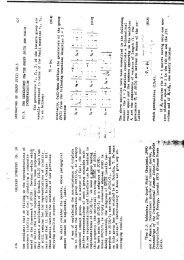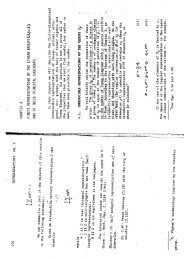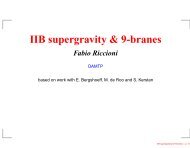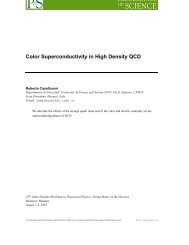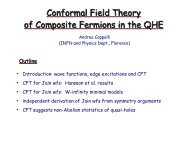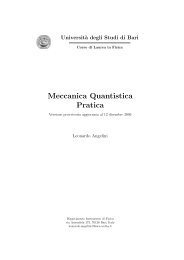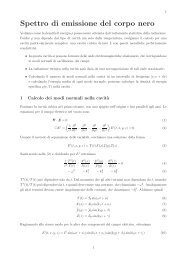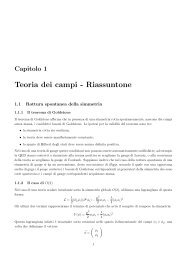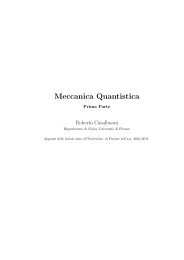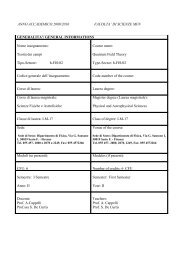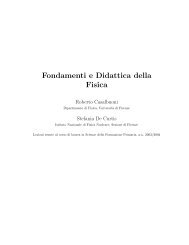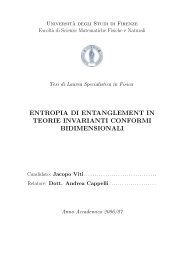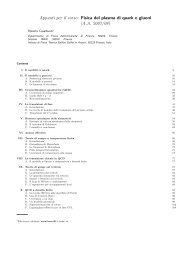arXiv:hep-ph/9804260 v2 16 Jun 1998 - Florence Theory Group
arXiv:hep-ph/9804260 v2 16 Jun 1998 - Florence Theory Group
arXiv:hep-ph/9804260 v2 16 Jun 1998 - Florence Theory Group
Create successful ePaper yourself
Turn your PDF publications into a flip-book with our unique Google optimized e-Paper software.
Table 2.2: The strange content fractions XS for the J = 1/2 ground state compared to<br />
the flavor symmetric case (pure octet). Up to the provided precision the results coincide<br />
for e = 5.0 and e = 5.5. The differences to the pure octet case indicate the significance<br />
of the higher dimensional representations.<br />
N Λ Σ Ξ<br />
e = 5.0 0.<strong>16</strong> 0.25 0.30 0.37<br />
Octet 0.23 0.30 0.37 0.40<br />
try breaking in the soliton sector. For the soliton solution the σ field is always negative.<br />
Hence the contribution of the mass–type symmetry breaker to s(x) in eq (2.10) is sig-<br />
nificantly reduced as compared to the pure pseudoscalar case. As already discussed,<br />
the mass–type symmetry breaker strongly dominates over the kinetic–type, which is<br />
suppressed by the factor e 2σ . Since applying the breathing mode approach to the pure<br />
pseudoscalar model (i.e. σ ≡ 0) overestimates the flavor symmetry breaking in the<br />
baryon mass differences [<strong>16</strong>], the incorporation of the scalar glueball field improves on<br />
the predicted baryon spectrum [17]. In the pure Skyrme model a reduction of symmetry<br />
breaking effects can be gained by decreasing the Skyrme constant e. Unfortunately this<br />
also lowers the difference between the nucleon and the ∆ masses. As can be observed<br />
from table 1 in ref [<strong>16</strong>] an overall satisfactory picture cannot be obtained in the breathing<br />
mode approach to the pure pseudoscalar model.<br />
In figure 2.1 the dominant pieces of the radial wave–functions<br />
f (B,m)<br />
µ<br />
(x) = <br />
nµ<br />
C (B,m)<br />
µ,nµ f(0) µ,nµ (x) (2.14)<br />
are shown for the 1+<br />
(0)<br />
ground states. Here f (x) denote the radial eigenfunctions of the<br />
2<br />
µ,nµ<br />
flavor symmetric formulation (2.11) multiplied by (α3 (x)β4 (x)/m(x)) (1/4) [<strong>16</strong>]. It should<br />
be noted that these radial wave–functions are normalized with respect to a metric m(x)<br />
which is singular at x = 0, cf. eq (2.10). Hence all wave–functions vanish at that<br />
particular point. We observe that these ground states are dominated by the radial<br />
ground state in the octet representation. Nevertheless the contributions from the higher<br />
dimensional representations are not negligible either. This can also be seen from the<br />
strange content fractions of these baryons. This quantity can be associated with the<br />
matrix elements XS = 〈(1 − D88)/3〉 [31]. The sizable deviations from the pure octet<br />
results are shown in table 2.2. It is also interesting to note that the strange content<br />
fraction for the Roper and the N(1710) respectively decrease from 23% to 14% and from<br />
25% to 19% (e = 5.0) due to flavor symmetry breaking.<br />
9



